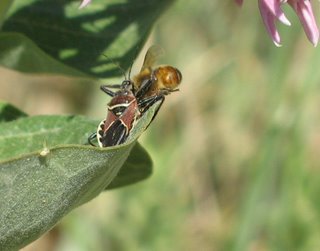 One of the attractions was the abundant thistle crop, both native and introduced. We think this one, happily, is a native-- either the Wavy-leaved Thistle (Cirsium undulatum) or perhaps a close relative, Cirsium ochrocentrum. (Depends on whether you consider the leaves deeply pinnatifid and the upper leaf surface less canescent than the lower. If so, go with the C. ochrocentrum. I think I will.)
One of the attractions was the abundant thistle crop, both native and introduced. We think this one, happily, is a native-- either the Wavy-leaved Thistle (Cirsium undulatum) or perhaps a close relative, Cirsium ochrocentrum. (Depends on whether you consider the leaves deeply pinnatifid and the upper leaf surface less canescent than the lower. If so, go with the C. ochrocentrum. I think I will.)The important thing is that the flowers were putting out lunch for a couple of our spineless friends. The large grasshopper was clearly enjoying the thistle, as he soon dove into the blossoms head first. A Yellow Tiger Swallowtail (minus one tail) paused at a nearby flower, and the three seemed to be happily enjoying the sunshine and service.

The third party, however, turned out to have no interest in nectaring. He did, in fact, react to our presence, seeming a little skittish or perhaps just alert. I've always kind of called these guys "shield bugs" in my informal taxonomy, but around the corner a new name popped into my head.
 On a patch of Showy Milkweed (Asclepias speciosa), we found a literal circus of the spineless. A bug-hunter's paradise, these yummy flowers were a-buzz with attention from huge bumblebees and other pollinators.
On a patch of Showy Milkweed (Asclepias speciosa), we found a literal circus of the spineless. A bug-hunter's paradise, these yummy flowers were a-buzz with attention from huge bumblebees and other pollinators.But there's something else going on in the lower right part of the photo. A honeybee was not enjoying the activity of his (her?) fellows, but was remarkably still. Closer examination revealed that he was in the grip of the Assassin Bug, as my colorful friends were now revealed to be. The bee was long dead, and the Bug was sucking out its liquefied innards as we watched. Sharp eyes will also find a different ambush specialist in this photo, and two more Assassin Bugs in the photo above.

A little online sleuthing clarifies these able predators, some species of which even attack humans and, in Mexico, carry Chagas disease. And I always thought they were cute! The moral is, be a little careful around these guys, as even the insect-eaters can inflict painful bites. More reading here and here. And if anyone can give me genus/species on this little guy, it'd be appreciated! (I gather they belong to the family Reduviidae, but that's as far as I've gotten.)
Much later update: Thanks to Ted, of Beetles in the Bush, we now know these are Apiomerus spissipes. More photos and information here. Thanks, Ted!!
For more stories on bugs and other boneless types, check out Circus of the Spineless, an ongoing guide to invertebrates online.

1 comment:
The assassin bug is a species of Apiomerus - in your area this should probably be A. spissipes. The genus name makes reference to bees as their usual prey.
regards--ted
Post a Comment